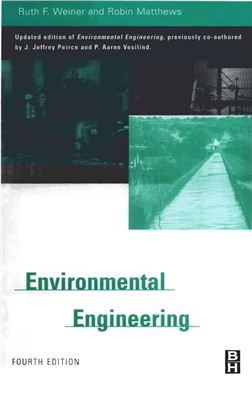Fourth edition, Publisher: Elsevier Science, 2003., 510 pages.
Everything seems to matter in environmental engineering. The social sciences and humanities, as well as the natural sciences, can be as important to the practice of environmental engineering as classical engineering skills. Many environmental engineers find this combination of skills and disciplines, with its inherent breadth, both challenging and rewarding. In universities, however, inclusion of these disciplines often requires the environmental engineering student to cross discipline and department boundaries. Deciding what to include in an introductory environmental engineering book is critical but difficult, and this difficulty has been enhanced by the growth of environmental engineering since the first edition of this book.
The text is organized into areas important to all environmental engineers: water resources, air quality, solid and hazardous wastes (including radioactive wastes), and noise. Chapters on environmental impact assessment and on risk analysis are also included. Any text on environmental engineering is somewhat dated by the time of publication, because the field is moving and changing rapidly. We have included those fundamental topics and principles on which the practice of environmental engineering is grounded, illustrating them with contemporary examples. We have incorporated emerging issues, such as global climate change and the controversy over the linear nonthreshold theory, whenever possible.
This book is intended for engineering students who are grounded in basic physics, chemistry, and biology, and who have already been introduced to fluid mechanics. The material presented can readily be covered in a one-semester course.
The authors are indebted to Professor P. A. Vesilind of Bucknell University and Professor J. J. Peirce of Duke University, the authors of the original Environmental Engineering.
Contents.
Environmental Engineering.
Assessing Environmental Impact.
RiskAnalysis.
Water Pollution.
Measurement of Water Quality.
Water Supply.
Water treatment.
Collection of Wastewater.
Wastewater Treatment.
Sludge Treatment and Disposal.
Nonpoint Source Water Pollution.
Solid Waste.
Solid Waste Disposal.
Reuse, Recycling, and Resource Recovery.
Hazardous Waste.
Radioactive Waste.
Solid and Hazardous Waste Law.
Meteorology and Air Pollution.
Measurement of Air Quality.
Air Pollution Control.
Air Pollution Law.
Noise Pollution.
Appendices.
A Conversion Factors.
B Elements of the Periodic Table.
Everything seems to matter in environmental engineering. The social sciences and humanities, as well as the natural sciences, can be as important to the practice of environmental engineering as classical engineering skills. Many environmental engineers find this combination of skills and disciplines, with its inherent breadth, both challenging and rewarding. In universities, however, inclusion of these disciplines often requires the environmental engineering student to cross discipline and department boundaries. Deciding what to include in an introductory environmental engineering book is critical but difficult, and this difficulty has been enhanced by the growth of environmental engineering since the first edition of this book.
The text is organized into areas important to all environmental engineers: water resources, air quality, solid and hazardous wastes (including radioactive wastes), and noise. Chapters on environmental impact assessment and on risk analysis are also included. Any text on environmental engineering is somewhat dated by the time of publication, because the field is moving and changing rapidly. We have included those fundamental topics and principles on which the practice of environmental engineering is grounded, illustrating them with contemporary examples. We have incorporated emerging issues, such as global climate change and the controversy over the linear nonthreshold theory, whenever possible.
This book is intended for engineering students who are grounded in basic physics, chemistry, and biology, and who have already been introduced to fluid mechanics. The material presented can readily be covered in a one-semester course.
The authors are indebted to Professor P. A. Vesilind of Bucknell University and Professor J. J. Peirce of Duke University, the authors of the original Environmental Engineering.
Contents.
Environmental Engineering.
Assessing Environmental Impact.
RiskAnalysis.
Water Pollution.
Measurement of Water Quality.
Water Supply.
Water treatment.
Collection of Wastewater.
Wastewater Treatment.
Sludge Treatment and Disposal.
Nonpoint Source Water Pollution.
Solid Waste.
Solid Waste Disposal.
Reuse, Recycling, and Resource Recovery.
Hazardous Waste.
Radioactive Waste.
Solid and Hazardous Waste Law.
Meteorology and Air Pollution.
Measurement of Air Quality.
Air Pollution Control.
Air Pollution Law.
Noise Pollution.
Appendices.
A Conversion Factors.
B Elements of the Periodic Table.

